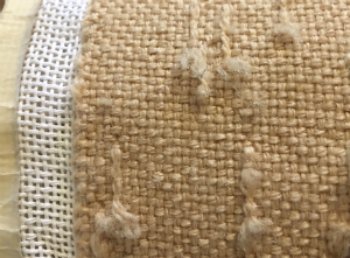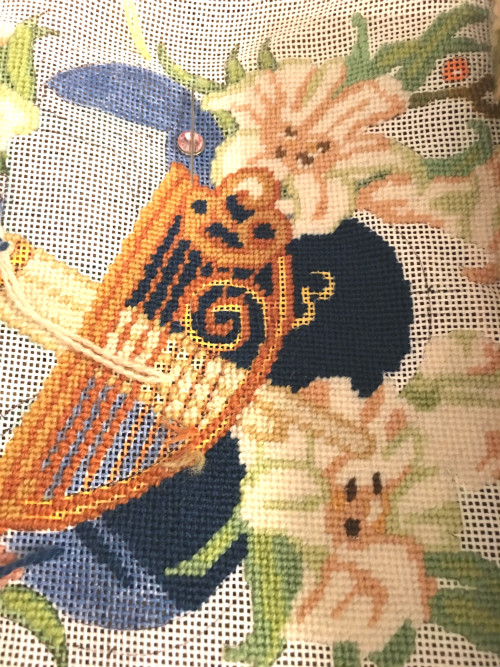
Recently the folks at Needlepoint for Fun posted about a problem a customer was having with the back of her stitching. They offered some suggestions and asked readers for others. Today in the guest post, read what they learned.
*************
We get lots of inquiries here at Needlepoint For Fun, and recently a customer wrote to us saying her basketweave had inexplicably developed ‘knobbly knees’ (that wasn’t how she put it but that’s essentially what had happened).
Our friend-in-need had always stitched on a frame and her basketweave had always looked like it does in this image below; that is to say, exactly how it’s supposed to – smooth and even on both sides of the canvas.

One day, she started working a piece for a friend, and just like the fire hydrant always jumps out when you’re driving another person’s car, this happened (see picture at the top of the article). . .
Yep, knobbly knees.
She couldn’t figure out what she was doing differently, and we weren’t sure, either. We first suggested that maybe she had started stitching against the grain of the canvas i.e. down the steps and up the poles instead of the opposite (correct) way.
We were assured that steps were being stitched up and poles slid down. So, we suggested that maybe the thread had twisted and this was causing lumps on the back of the canvas – but the front of the canvas looked fine so this didn’t really make sense.

So, we sent the problem out to our newsletter readership and we got some great replies. Here are some of our reader suggestions for why you might run into problems when stitching needlepoint basketweave:
- If the needle enters the canvas at an altered angle it can make the threads look thinner in one direction compared to the other.
- Knobby knees are caused by the yarn becoming twisted. All you have to do is let the yarn dangle every so often and you eliminate the problem. The twisting of the yarn causes a curl that resembles a knob.
- Perhaps the “grain” of the yarn/thread is not being attended to. All textiles, including thread and yarn, have a grain and will not run smoothly repeatedly through another fabric unless aligned and used in the smooth end first. This is particularly important when blending thread/yarn of different content or texture. The knobby knees in the photo look partially twisted or knotted, and that could come from using the yarn “upside down”. The stitcher has to check and maintain proper tension on the multi ply yarn at the eye of the needle so that one strand isn’t “free” to hang back.
- The thread being used may be too thick for the canvas mesh. When using the stab method in basketweave, slant the needle when going into the canvas. On both the up and down rows, the hole you are going down into, while empty of thread, is essentially covered on the back by the thread from the previous row (that “stitch” on the back is a straight stitch over two canvas threads). If you truly stab at right angles to the canvas, you will naturally tend to pierce that thread. If you make an effort to slant your needle in the direction you would if you were sewing, then you are more likely to clear the thread on the back and get a normal basketweave pattern on the back.
- A larger needle might help (prevent the thread from bunching up).
- Some yarns/threads have a very high twist and give a textured appearance.
- The stitch and stab method works fine until you are dealing with certain threads that like to explode on the back for no apparent reason. If this happens, keep the project on stretcher bars or a frame, insert the needle to take a stitch as usual, but don’t pull the thread through to the back. Insert the needle in the canvas as you would to bring the thread to the front. Then, pull the entire thread through to the front with the thread slipping along the back of the canvas. This does cause additional abrasion to the thread, so use shorter lengths to compensate.
And here’s some other, equally good advice we received:
- Don’t sweat it; it doesn’t matter what the back looks like (a big tick to that one).
- The canvas was harboring a gremlin (which essentially means the same thing – don’t sweat it as long as the front looks okay).
We hope this helps smooth out any basketweave problems you might have.
About Janet M Perry
Janet Perry is the Internet's leading authority on needlepoint. She designs, teaches and writes, getting raves from her fans for her innovative techniques, extensive knowledge and generous teaching style. A leading writer of stitch guides, she blogs here and lives on an island in the northeast corner of the SF Bay with her family

Leave a Reply